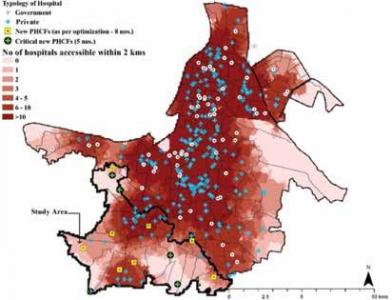
In a resource-constrained society in developingnations like India, the importance of health care infrastructure allocation is often undermined and overlooked. We have looked into the issue of access from the perspective of policy making and resource allocation as well as from the people’s needs and demand. While affordability, accessibility and availability varies among the heterogeneous urban fabric in urban India, our research focus has been on the formulations of (i) strategies to ensure access to facilities and to
develop models to locate the facilities for all socio economic sections and (ii) analysing the policies that governs the healthcare service allocation and delivery. For the years, it has been noted that share of the health seeker’s choice have shifted towards private facilities in spite of them being expensive. Consequently the event of health shocks have emerged.
In recent past, the health policy formulations in India have witnessed a shift from a reactive approach to a more proactive approach over the last decade. It is therefore important to understand the effectiveness of recent national health policies (such as the National Rural Health Mission and the National Urban Health Mission) in addressing the varied needs of the heterogeneous population of India.
We have been working with several social enterprises and NGOs to help in reaching out to the disadvantaged group in cities like Mumbai, Kolkata, and Indore to name a few. Several location allocation models (refer image) has been developed to aid in implementing new facilities.
These algorithms have been further extended to model the emergency response system (such as ambulances, fire engines and so on) for the dynamic need of the city while considering the varying texture of the city. To ensure equitable access to healthcare, a comprehensive health informatics system is needed, to ensure that healthcare services reach to the doorstep of those who needs most.
Prof. Arnab Jana
